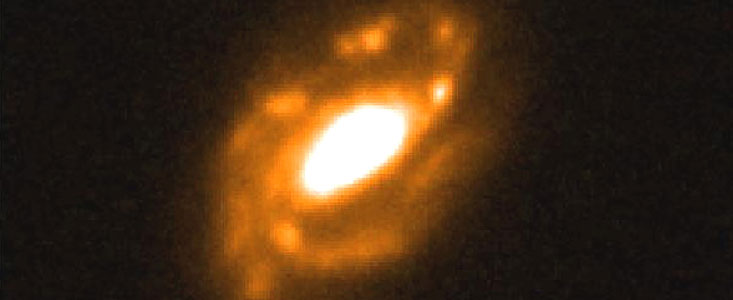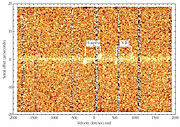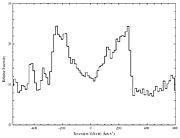Communiqué de presse
Most Massive Spiral Galaxy Known in the Universe
The VLT Observes Rapid Motion in Distant Object
8 décembre 2000
The most massive spiral galaxy known so far in the Universe has been discovered by a team of astronomers from Garching, Padova, Leiden, ESO and London [1]. They base their conclusion on recent observations with ISAAC, an infrared-sensitive, multi-mode instrument on ESO's Very Large Telescope at the Paranal Observatory. This galaxy has been designated ISOHDFS 27 and is located at a distance of approx. 6 billion light-years (the redshift is 0.58). Its measured mass is more than 1000 billion times that of the Sun [2]. It is thus about four times more massive than our own galaxy, the Milky Way, and twice as heavy as the heaviest spiral galaxy known so far.
The determination of the mass of ISOHDFS 27 is based on a unique measurement of the motions of its stars and nebulae around the center. The faster the motion is, the greater is the mass. It is, in essence, the same method that allows determining the mass of the Earth from the orbital speed and distance of the Moon.
This is the first time a "rotation curve" has been observed in such a distant galaxy by means of infrared observations, allowing a very detailed dynamical study. Other observations by the team concern a pair of distant, interacting galaxies that were also found to possess comparably high masses. They also have observations of a third galaxy at a distance of about 10 billion light-years, with a mass that approaches that of ISOHDFS 27.
The new result has important cosmological implications, as it demonstrates that very heavy structures had already been formed in the Universe at a comparatively early epoch.
Star formation in young galaxies
It is of fundamental importance to current cosmological studies to understand how stars evolve within galaxies and how the galaxies themselves evolve into the various shapes we observe. Some are elliptical, others have the form of single or multiple spirals. Quite a few, especially smaller ones, appear to have no particular structure at all and are referred to as "irregular".
With the advent of large optical/infrared telescopes like the ESO VLT, astronomers are now able to observe extremely distant objects and hence to "look back" to the time when galaxies were being formed in the young Universe. They have found it particularly useful to observe in the infrared part of the spectrum during the present search for "young galaxies". Such observations minimize the effects of dust obscuration and serve to trace the active phases of galaxy evolution, i.e. those specific periods of time when there is particularly intense star-formation in a galaxy.
It is still not well known what triggers such phases of enhanced star-forming activity, but it is suspected that galaxy collisions and mergers may play an important role. The formation of stars usually takes place deep inside thick dust clouds that absorb the optical and UV light from the young stars and re-emit it in the infrared region of the spectrum. The imprints of this type of activity are thus best observed in that spectral band. Indeed, the infrared spectra of such objects have been found to undergo huge variations that relate to the related, complex processes.
Infrared observations are therefore crucial for the study of these most violent episodes in the Universe. By means of detailed observations of distant galaxies, we may hope to learn how they occurred at earlier times and, in particular, how the major structures (e.g., spirals, bulges) that we now see in most galaxies were formed.
Dusty Infrared-Luminous Galaxies
In 1995-98, the infrared camera ISOCAM onboard the ESA Infrared Space Observatory (ISO), with its unique imaging capabilities, provided astronomers with the first deep, overall "infrared view" of the Universe. Through various deep surveys with ISO, a new class of objects was discovered: luminous, distant galaxies detected during transient phases of enhanced infrared emission and undergoing rapid evolution with cosmic time.
One of the sky areas surveyed by ISO was the Hubble Deep Field South (HDF-S), that has also been observed with various ESO telescopes including the VLT, cf. eso9820.
The present team of astronomers decided to investigate some of the luminous galaxies that were detected by ISOCAM in the HDF-S area. Their goal was to better understand the enigmatic nature of these unsual objects and to try to learn which processes are really behind those huge amounts of energy that are emitted by these galaxies in the infrared region of the spectrum.
However, all of the galaxies in HDF-S are at very large distances - several billion light-years away (i.e. with redshifts between 0.6 and 1.5) and they are rather faint. They refer to these objects as ISOHDFS galaxies and their colours are quite red. The astronomers therefore decided to use one of the most efficient astronomical infrared instruments now available, the multi-mode ISAAC on the 8.2-m VLT ANTU telescope.
VLT Observations of ISOHDFS galaxies
In September 1999, the team began to obtain low-resolution spectra of about one dozen of these galaxies. This initial observing run at Paranal was very successful and it provided a first clue towards the true nature of these systems. It was found, in particular, that ISOHDFS galaxies emit strongly in the H-alpha spectral line from hydrogen atoms and that this emission originates in dusty regions with intense star formation activity in these galaxies.
The astronomers determined accurate redshifts (and hence, distances to the individual galaxies) by measuring the Doppler shifts of the H-alpha lines in their infrared spectra (an example of an early observation of this type is shown in ESO Press Release eso9856).
Inspired by the excellent quality of these first VLT observations, they were ready to take the next, challenging step in August 2000. They now attempted to get a deeper insight into the nature and dynamical stage of the ISOHDFS galaxies, by means of measurements of the stellar masses in the nuclear regions of these objects.
The spectrum of ISOHDFS 27
The first target for this new study was a large spiral galaxy, designated ISOHDFS 27 and of which an HST image is shown in ESO Press Photo eso0040 . The superb observing conditions at Paranal - the seeing improved to the near-record value of only 0.2 arcsec during the acquisition of these data! - made it possible to obtain the first spatially resolved, infrared H-alpha spectra of some of the ISOHDFS galaxies, allowing for the first time a probe into the dynamical stage of these distant objects.
ESO Press Photo eso0041 shows the "raw" ISAAC spectrum, i.e. the image of the spectrum as seen in the read-out from the detector.
The derived spectral profile of the H-alpha line is shown in ESO Press Photo eso0041 . The shape is very unusual and implies that the emitting region is probably not concentrated at the centre of the galaxy, but most likely has a disk-like structure. Taking into account the inclination of the galaxy (50°), the difference in velocity between the two peaks is 830 km/sec, i.e. the rotational velocity is half of that, 415 km/sec, or significantly more than what is measured in normal spiral galaxies.
This was an interesting start for an ambitious project. But the astronomers got really excited when they made the first estimate of the total mass of that galaxy.
"I can't believe it, this spiral galaxy is really massive!" said Dimitra Rigopoulou from the Garching team. And she added: "With an estimated mass of 10 12 times that of our Sun and 4 times the mass of our own Galaxy, it seems to be the most massive spiral galaxy found so far in the Universe!" Indeed, careful calculations later showed that a total mass of 1.04 10 12 solar masses is present within 4 arcsec of the central region of (an area of 8 arcsec across), corresponding to 100,000 light-years (40 kpc) in ISOHDFS 27 . This is enormous by all standards [3]. The baryonic mass which corresponds to the mass in the older stars and is estimated from the infrared spectrum, is found to be 6 x10 11 solar masses, about half the dynamical mass.
During the same observing run, two other ISO-detected infrared sources were observed. One turned out to be a system of two counter-rotating galaxies with masses of about 2 x 10 11 solar masses and the other an even more distant galaxy (about 12 billion light-years) with comparably high mass.
Implications and Future Plans
The present programme is a fine illustration of the importance of "collaboration" between space- and ground-based telescopes. While the galaxies were first found with ISO and HST, it took the enormous light-gathering capability of the VLT to obtain a detailed spectrum and measure their masses.
Clearly, these exciting results have important implications for future studies of formation and evolution of galaxies, as well as the origin of the IR background.
The discovery of such massive spiral galaxies at very large distances implies that enormous structures were in place in the Universe, already some 6 billion years ago.
Galaxies like ISOHDFS 27 which are strongly emitting in the infrared region of the spectrum are presumed to contribute significantly to the observed infrared background radiation. Consequently, these new observations imply that the infrared background is largely made up of massive galaxies with recent star formation activity.
The team now plans to continue its work on the determination of the dynamical status of other high-redshift galaxies. These studies are indeed very timely since a plethora of future space- and ground-based missions such as NGST, SIRTF, FIRST and ALMA will be able to perform even more detailed follow-up observations of these objects.
The present observations open a new and exciting era in the study of the formation of galaxies in the young Universe.
Notes
[1] The project on exploring the dynamical stage of ISO-detected galaxies in the Hubble Deep Field South is being carried out by a large international collaboration led by astronomers from the Max-Planck-Institut für Extraterrestrische Physik (MPE) in Garching (Germany) and the Padova University (Italy). Besides Dimitra Rigopoulou and Alberto Franceschini , the team includes Herve Aussel (Padova), Catherine Cesarsky (ESO), Reinhard Genzel (MPE), David Elbaz (Saclay, France), Michael Rowan-Robinson (IC, UK), Niranjan Thatte (MPE), and Paul van der Werf (Leiden, The Netherlands).
[2] 1 billion = 1,000 million = 10^9.
[3] Some other distant spiral galaxies have been found with masses in the range of 1 - 5 x 10^11 solar masses. The heaviest spiral galaxy known until now is UGC 12591, with a measured mass of 6 x10^11 solar masses.
Contacts
Dimitra Rigopoulou
Max-Planck-Institut fuer Extraterrestrische Physik
Garching, Germany
Tél: +49-89-30000-3392
Courriel: dar@mpe.mpg.de
A propos du communiqué de presse
| Communiqué de presse N°: | eso0041 |
| Legacy ID: | PR 25/00 |
| Nom: | ISOHDFS 27, Spectrum |
| Type: | Early Universe : Galaxy : Type : Spiral Early Universe : Galaxy : Size : Giant |
| Facility: | Very Large Telescope |
| Instruments: | ISAAC |
Our use of Cookies
We use cookies that are essential for accessing our websites and using our services. We also use cookies to analyse, measure and improve our websites’ performance, to enable content sharing via social media and to display media content hosted on third-party platforms.
ESO Cookies Policy
The European Organisation for Astronomical Research in the Southern Hemisphere (ESO) is the pre-eminent intergovernmental science and technology organisation in astronomy. It carries out an ambitious programme focused on the design, construction and operation of powerful ground-based observing facilities for astronomy.
This Cookies Policy is intended to provide clarity by outlining the cookies used on the ESO public websites, their functions, the options you have for controlling them, and the ways you can contact us for additional details.
What are cookies?
Cookies are small pieces of data stored on your device by websites you visit. They serve various purposes, such as remembering login credentials and preferences and enhance your browsing experience.
Categories of cookies we use
Essential cookies (always active): These cookies are strictly necessary for the proper functioning of our website. Without these cookies, the website cannot operate correctly, and certain services, such as logging in or accessing secure areas, may not be available; because they are essential for the website’s operation, they cannot be disabled.
Functional Cookies: These cookies enhance your browsing experience by enabling additional features and personalization, such as remembering your preferences and settings. While not strictly necessary for the website to function, they improve usability and convenience; these cookies are only placed if you provide your consent.
Analytics cookies: These cookies collect information about how visitors interact with our website, such as which pages are visited most often and how users navigate the site. This data helps us improve website performance, optimize content, and enhance the user experience; these cookies are only placed if you provide your consent. We use the following analytics cookies.
Matomo Cookies:
This website uses Matomo (formerly Piwik), an open source software which enables the statistical analysis of website visits. Matomo uses cookies (text files) which are saved on your computer and which allow us to analyze how you use our website. The website user information generated by the cookies will only be saved on the servers of our IT Department. We use this information to analyze www.eso.org visits and to prepare reports on website activities. These data will not be disclosed to third parties.
On behalf of ESO, Matomo will use this information for the purpose of evaluating your use of the website, compiling reports on website activity and providing other services relating to website activity and internet usage.
Matomo cookies settings:
Additional Third-party cookies on ESO websites: some of our pages display content from external providers, e.g. YouTube.
Such third-party services are outside of ESO control and may, at any time, change their terms of service, use of cookies, etc.
YouTube: Some videos on the ESO website are embedded from ESO’s official YouTube channel. We have enabled YouTube’s privacy-enhanced mode, meaning that no cookies are set unless the user actively clicks on the video to play it. Additionally, in this mode, YouTube does not store any personally identifiable cookie data for embedded video playbacks. For more details, please refer to YouTube’s embedding videos information page.
Cookies can also be classified based on the following elements.
Regarding the domain, there are:
- First-party cookies, set by the website you are currently visiting. They are stored by the same domain that you are browsing and are used to enhance your experience on that site;
- Third-party cookies, set by a domain other than the one you are currently visiting.
As for their duration, cookies can be:
- Browser-session cookies, which are deleted when the user closes the browser;
- Stored cookies, which stay on the user's device for a predetermined period of time.
How to manage cookies
Cookie settings: You can modify your cookie choices for the ESO webpages at any time by clicking on the link Cookie settings at the bottom of any page.
In your browser: If you wish to delete cookies or instruct your browser to delete or block cookies by default, please visit the help pages of your browser:
Please be aware that if you delete or decline cookies, certain functionalities of our website may be not be available and your browsing experience may be affected.
You can set most browsers to prevent any cookies being placed on your device, but you may then have to manually adjust some preferences every time you visit a site/page. And some services and functionalities may not work properly at all (e.g. profile logging-in, shop check out).
Updates to the ESO Cookies Policy
The ESO Cookies Policy may be subject to future updates, which will be made available on this page.
Additional information
For any queries related to cookies, please contact: pdprATesoDOTorg.
As ESO public webpages are managed by our Department of Communication, your questions will be dealt with the support of the said Department.



